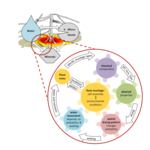The role of self-assembling of root mucilage for the formation of spatiotemporal wettability pattern in the rhizosphere
Laufzeit: 01.10.2018 - 30.09.2021
Förderkennzeichen: 403668613
Förderung durch: Deutsche Forschungsgemeinschaft (DFG) SPP 2089: Rhizosphere Spatiotemporal Organisation - a Key to Rhizosphere Functions
Projektmittel (€): 235717
Kurzfassung
Root mucilage, a polysaccharide hydrogel, may render soil hydrophobic after drying and buffers extreme hydraulic conditions in the rhizosphere. Until now, little is known about how this buffering behavior depends on chemical and chemico-physical properties of mucilage and how these properties respond to different environmental conditions in the rhizosphere.In the frame of the SPP (topic 4, water flux/drought/mucilage/hydrophobicity), we aim at answering the following questions: Which role do...Root mucilage, a polysaccharide hydrogel, may render soil hydrophobic after drying and buffers extreme hydraulic conditions in the rhizosphere. Until now, little is known about how this buffering behavior depends on chemical and chemico-physical properties of mucilage and how these properties respond to different environmental conditions in the rhizosphere.In the frame of the SPP (topic 4, water flux/drought/mucilage/hydrophobicity), we aim at answering the following questions: Which role do chemical hydrogel properties play for the physical properties of root mucilage of different plants? How do the physical properties influence their drying behavior and the resulting spatial patterns of dried mucilage? Which consequences do these spatial patterns have for hydraulic properties of the rhizosphere during drying and rewetting?Our main hypothesis is strongly linked to the part of the general SPP hypothesis 1 that postulates that self-organization in the rhizosphere leads to an efficient water acquisition by plants due to the formation of specific spatiotemporal patterns. We hypothesize that mucilage is a self-assembled hydrogel which, due to its specific chemical structure, may respond to changes in the surrounding conditions by modifying its supramolecular arrangement. The supramolecular arrangement influences its physical properties which in turn determine the spatial arrangement of the polysaccharides during drying and by this also the hydraulic properties during the subsequent rewetting.By a combination of dialysis and swelling experiments with mucilage of different plants we will study the effect of environmental conditions (pH, cations, surface active substances) on physical hydrogel properties and link it to the results of chemical analysis (monosaccharide, linkage analysis, total contents). Macroscopic rheology, 1H-NMR (for water mobility) and differential scanning calorimetry (DSC, for non-freezing water), will be employed together with microscale methods, such as atomic force microscopy (AFM), for the determination of surface tension, viscosity and elasticity. These AFM measurements will be included as input parameters into a simulation of liquid bridges of mucilage during drying. Therefore, methods from continuum mechanics (describing the network of polysaccharids) are coupled to Lattice Boltzmann methods (describing water flow within the pore space). Furthermore, we will experimentally and numerically quantify the relation between microscopical drying patterns of mucilage to its macroscopic wettability (contact angle) and to macroscopic hydraulic properties such as rhizosphere water retention and its hysteresis. Finally, our results will be tested by insitu 1H-NMR measurements in mini pot experiments (SPP maize).Coupling molecular-chemical properties and nanoscale-spatial arrangement of mucilage with macroscale-hydraulic processes may significantly improve our understanding of the rhizosphere as a dynamic self-organized system.» weiterlesen» einklappen
Veröffentlichungen
- Diehl, Doerte; Knott, Mathilde; Schaumann, Gabriele E.
- Purification effects show seed and root mucilage's ability to respond to changing rhizosphere conditions
- Knott, Mathilde; Ani, Mina; Kroener, Eva et al.
- Effect of Changing Chemical Environment on Physical Properties of Maize Root Mucilage
- Schnepf, A.; Carminati, A.; Ahmed, M. A. et al.
- Linking Rhizosphere Processes across Scales: Opinion
- Werner, Lena M.; Knott, Matthilde; Diehl, Doerte et al.
- Physico-Chemical Properties of Maize (Zea mays L.) Mucilage Differ with the Collection System and Corresponding Root Type and Developmental Stage of the Plant
- Buchmann, Christian; Steinmetz, Zacharias; Brax, Mathilde et al.
- Effect of matric potential and soil-water-hydrogel interactions on biohydrogel-induced soil microstructural stability
- Brax, Mathilde; Buchmann, Christian; Kenngott, Kilian et al.
- Influence of the physico-chemical properties of root mucilage and model substances on the microstructural stability of sand
- Benard, Pascal; Zarebanadkouki, Mohsen; Brax, Mathilde et al.
- Microhydrological Niches in Soils: How Mucilage and EPS Alter the Biophysical Properties of the Rhizosphere and Other Biological Hotspots

